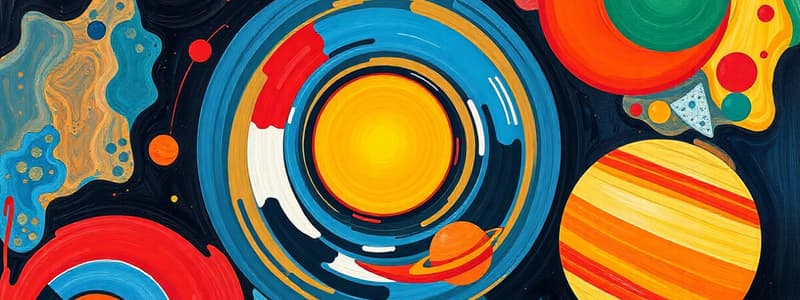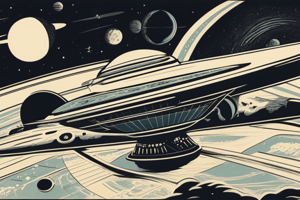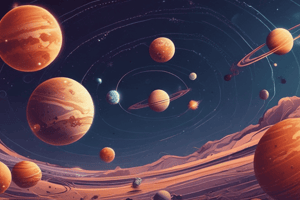Podcast
Questions and Answers
Which of the following best describes the primary difference between a planet and a dwarf planet?
Which of the following best describes the primary difference between a planet and a dwarf planet?
- A planet is primarily rocky, while a dwarf planet is primarily icy.
- A planet orbits a star, while a dwarf planet orbits a moon.
- A planet is larger than a dwarf planet.
- A planet has cleared its orbital path, while a dwarf planet has not. (correct)
The asteroid belt is located between the orbits of Venus and Earth.
The asteroid belt is located between the orbits of Venus and Earth.
False (B)
What is the primary cause of seasonal changes on Earth?
What is the primary cause of seasonal changes on Earth?
Earth's tilt
The streak of light observed when a meteoroid burns in Earth's atmosphere is called a ________.
The streak of light observed when a meteoroid burns in Earth's atmosphere is called a ________.
Match the following terms related to the universe with their correct descriptions:
Match the following terms related to the universe with their correct descriptions:
What process primarily fuels stars by converting hydrogen into helium?
What process primarily fuels stars by converting hydrogen into helium?
A solar eclipse occurs when the Earth passes between the Sun and the Moon, casting a shadow on the Moon.
A solar eclipse occurs when the Earth passes between the Sun and the Moon, casting a shadow on the Moon.
What is the Oort cloud believed to be the primary source of?
What is the Oort cloud believed to be the primary source of?
The boundary around a black hole beyond which nothing can escape is called the ________.
The boundary around a black hole beyond which nothing can escape is called the ________.
Which of the following spectral types represents the coolest stars?
Which of the following spectral types represents the coolest stars?
Rotation is the term for a planet orbiting the sun.
Rotation is the term for a planet orbiting the sun.
What does the H-R diagram classify?
What does the H-R diagram classify?
Universe expansion is proven by ________.
Universe expansion is proven by ________.
Match the following terms with their definitions:
Match the following terms with their definitions:
What is the Kuiper Belt?
What is the Kuiper Belt?
Dark matter explains extra energy in galaxies..
Dark matter explains extra energy in galaxies..
What astronomical object lands on Earth?
What astronomical object lands on Earth?
Objects orbiting beyond Neptune are known as ________ objects.
Objects orbiting beyond Neptune are known as ________ objects.
Match the Earth movement with its result:
Match the Earth movement with its result:
In the life cycle of a low-mass star, what stage follows the red giant phase?
In the life cycle of a low-mass star, what stage follows the red giant phase?
Flashcards
Planet
Planet
Orbits a star, nearly round and clears its orbital path.
Dwarf Planet
Dwarf Planet
Like a planet, but hasn't cleared its orbit.
Moon
Moon
Natural satellite orbiting a planet.
Asteroid
Asteroid
Signup and view all the flashcards
Comet
Comet
Signup and view all the flashcards
Meteoroid
Meteoroid
Signup and view all the flashcards
Meteor
Meteor
Signup and view all the flashcards
Meteorite
Meteorite
Signup and view all the flashcards
Asteroid Belt
Asteroid Belt
Signup and view all the flashcards
Kuiper Belt
Kuiper Belt
Signup and view all the flashcards
Trans-Neptunian Objects
Trans-Neptunian Objects
Signup and view all the flashcards
Rotation
Rotation
Signup and view all the flashcards
Revolution
Revolution
Signup and view all the flashcards
Big Bang Theory
Big Bang Theory
Signup and view all the flashcards
Redshift
Redshift
Signup and view all the flashcards
Blueshift
Blueshift
Signup and view all the flashcards
Black Hole
Black Hole
Signup and view all the flashcards
Event Horizon
Event Horizon
Signup and view all the flashcards
H-R Diagram
H-R Diagram
Signup and view all the flashcards
Study Notes
Astronomical Objects
- Planet orbits a star, is nearly round, and has cleared its orbital path
- Dwarf Planet resembles a planet but hasn't cleared its orbit
- Moon is a natural satellite orbiting a planet
- Asteroid is a small, rocky object mainly found between Mars and Jupiter
- Comet is an icy body with a glowing coma and tail when near the Sun
- Meteoroid is a space rock fragment
- Meteor is the streak of light produced as a meteoroid burns in Earth's atmosphere
- Meteorite is a meteoroid that lands on Earth
Solar System Regions
- Asteroid Belt is located between Mars and Jupiter
- Kuiper Belt is a flat, icy disk beyond Neptune
- Oort Cloud is a spherical shell far beyond the planets and is the source of long-period comets
- Trans-Neptunian Objects orbit beyond Neptune
Earth Movements
- Rotation refers to a planet spinning on its axis, causing day and night
- Revolution is orbiting the Sun, causing seasons and yearly cycles
- Earth's Tilt is the primary cause of seasonal changes
Moon Phases & Eclipses
- Lunar Eclipse occurs when the Moon is in Earth's shadow
- Solar Eclipse happens when the Moon blocks sunlight from reaching Earth
- Full Moon is when the Moon is fully illuminated
- Phases of the Moon result from the Moon's orbit around Earth
Stars & Their Life Cycle
- Nuclear Fusion is the energy source of stars, converting hydrogen into helium
- Star Evolution (for low mass stars) follows this sequence: Main sequence -> Red giant -> Planetary nebula -> White dwarf
- High Mass stars end their life cycle as Supernova -> Neutron star or Black hole
- Spectral Types of stars are classified as O (hottest) -> B -> A -> F -> G -> K -> M (coolest)
- H-R Diagram graphs star brightness vs temperature and it is used to trace star evolution
The Universe
- Big Bang Theory states the universe began from an extremely hot, dense state
- CMB Radiation serves as evidence of the Big Bang
- Dark Matter explains extra mass observed in galaxies
- Dark Energy accounts for the acceleration in the universe's expansion
- Redshift indicates light is stretched, and object is moving away, implying the universe is expanding
- Blueshift indicates light is compressed, and object is approaching
- Doppler Effect is the change in wavelength due to motion
Black Holes
- Black Hole is a region of intense gravity from which nothing, including light, can escape
- Event Horizon is the boundary around a black hole beyond which no escape is possible
- Spaghettification is the stretching of objects due to extreme gravity near a black hole
- Time Dilation is the slowing of time in strong gravitational fields
Multiple Choice Concepts
- Planets can be either rocky (terrestrial) or gaseous (Jovian)
- Revolution means orbiting a star, while rotation means spinning on an axis
- Redshift proves the universe is expanding
- Coolest stars belong to spectral class M
- Venus is hotter than Mercury due to the greenhouse effect
Short Answer Tips
- Dark Matter explains the fast star speeds observed in galaxies
- CMB radiation supports the theory of an early, hot universe during the Big Bang
- H-R Diagram classifies stars and their life stages
- Ethical Concern involves avoiding contamination during space exploration
Studying That Suits You
Use AI to generate personalized quizzes and flashcards to suit your learning preferences.




